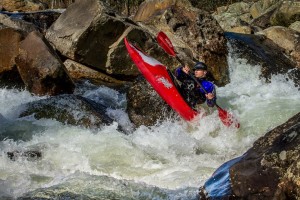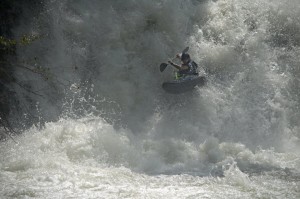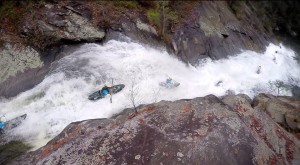
Michael Ferraro in action on Wilson Creek Gorge. Photo by James M. Brown.
When it comes to the winter, many students choose to stay inside and rarely feel the desire to venture out into the cold. Sophomore Michael Ferraro does not let the cold stop him from doing what he loves. The kayaking community around Western is relatively small but growing, and the kayakers around here are more than happy to introduce you to the sport and offer advice.
Ferraro competed in the Green Race for the first time in 2015, which is an intense, half mile whitewater course that draws some of the best athletes from all around the world. Just finishing was an accomplishment. He regularly kayaks on the Green River and Toxaway, which are some of the most challenging rivers in the area. As Ferraro mentioned in the Q&A, kayaking can be suited to any skill level, so there’s going to be something out there perfect for you.
“Kayaking is kayaking. Whether it’s wintertime or summertime. If you love the sport as much as I do, it won’t matter,” said Ferraro.
“Michael is definitely one of those paddlers that you want on the river with you. He is very situationally aware of what is going on and that is the kind of trait that could save someone’s life…Paddling with him makes for a much more relaxed day on the water,” said sophomore Brandon Williamson, who has spent time with Ferarro paddling class 4-5 water.
Here’s a Q&A with Ferraro about his kayaking experiences and advice he has for newcomers.

Michael mid-air on the Flight simulator at West fork of the Tuck. Photo by: Bryant Jones
WCJ: How did you get into kayaking?
MF: When I was 13 years old, my parents and I went out west to Montana one summer and we saw a kayaking competition. Guys were doing cool flips and tricks and I decided I wanted to do it because it looked awesome.
WCJ: Can anyone kayak?
MF: Kayaking is for everybody because there are a lot of different skill levels and a lot different rivers for those skill levels. The great thing about this area is you can drive 15 miles and go to a Class 1 or 2 (easy) river or drive the same amount and paddle the hardest whitewater that North Carolina has to offer, such as the Raven Fork in Cherokee, Nantahala Cascades, or the Green River Narrows just to name a few.
WCJ: Sounds great, I’m in. What are the first steps if you want to become a kayaker?
MF: Do research. A lot of it. You don’t want to get in over your head. After that, go to a roll clinic run by Base Camp Cullowhee, Thursdays from 7-9 p.m. or seek formal instruction of some sort. Then go on from there.
WCJ: Why do you continue kayaking in the winter?
MF: You have to have the right equipment to paddle in the winter. The main piece of equipment is a drysuit. It’s super cozy. Without it, it is dangerous. You can get hypothermia. You should be as warm or warmer than in the summertime.
[Michael suggests to buy your gear at Immersion Research. It doesn’t matter what season you start kayaking if you are well equipped.]
WCJ: What is your favorite part about kayaking?
MF: The places it takes me. It takes you places that people might have gone, but instead of looking down into the gorges, you are in the rapid and that is a really special thing.
Watch Michael’s 2015 Year in Review! GoPro shots compiled throughout 2015 by Ferarro.
WCJ: What’s the most dangerous situation you have ever been in?
MF: Most recent was on the Gauley River in West Virginia. This is a run that’s usually run by a lot of people and I kind of blew it off as a normal run that doesn’t have a whole lot of consequence. Eric Bartl and I were in the first rapid and I was following him through a slot move when my boat dried out on a rock and I began moving backwards into a sieve (where water flows through or under a rock). The sieve sucked me and my boat underneath it, snagging my paddle in half. I was upside down under a rock. I felt my boat was still moving down stream, so I hung on for a second. My boat popped out on the other side. So I swam and made it out
WCJ: In what part of kayaking do you feel the most awesome?
MF: When I’ve completed something new successfully, such as running a big rapid, new river, or a river that very few people have done before.
WCJ: What are ideal conditions?
MF: Depends on what skill level you’re at. If it’s snow or rain, it’s not a good idea to go out. On a lower grade river, it doesn’t really matter. My cutoff is 32 degrees most of the time.
At the end of the conversation with Ferraro, he had a final tip. If you are thinking of getting a kayak, “you gotta have a red boat so it will pop in pictures.”

Wintergreen rapid on Toxaway. Photo by: Boyd Ruppelt
Hopefully this will inspire you to get out and do what you love in the winter. You might even decide to get out and paddle. We live in a beautiful place to try out whitewater kayaking and have easy access to some great rivers, so why not give it a go?
Some basic boater terms that any beginner should know:
-Eddy: A slow moving or calm part of a river that is caused by rocks or debris.
-Beater: Someone that is bad at kayaking
-Stoked: You’re excited.
-Brown Claw: Term coined by the Pyranha Demshitz referring to the movie Borat.
-Jangler (Jangle): Referred to as someone who is moving slowly or who is late to go kayaking.


